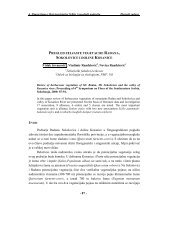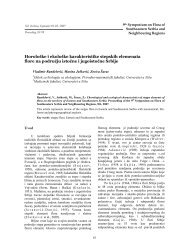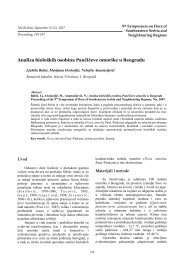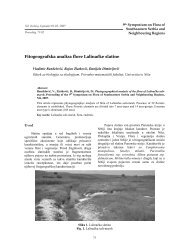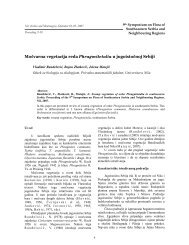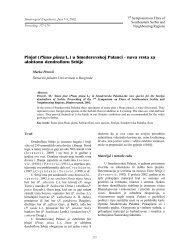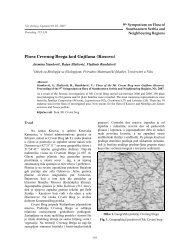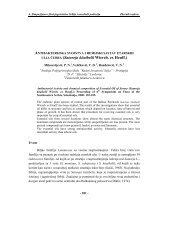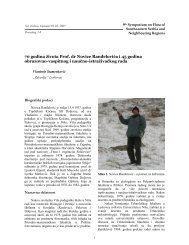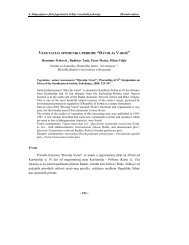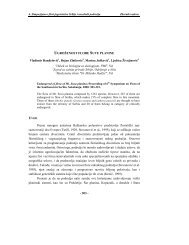10th Symposium on the Flora of Southeastern Serbia and ...
10th Symposium on the Flora of Southeastern Serbia and ...
10th Symposium on the Flora of Southeastern Serbia and ...
You also want an ePaper? Increase the reach of your titles
YUMPU automatically turns print PDFs into web optimized ePapers that Google loves.
10 th <str<strong>on</strong>g>Symposium</str<strong>on</strong>g> <strong>on</strong> <strong>the</strong> <strong>Flora</strong> <strong>of</strong> Sou<strong>the</strong>astern <strong>Serbia</strong> <strong>and</strong> Neighbouring regi<strong>on</strong>s,Vlasina 17 to 20 June 2010<strong>Flora</strong> <strong>and</strong> vegetati<strong>on</strong> <strong>of</strong> Vlasina plateauRanđelović, V., Zlatković, B.Department <strong>of</strong> Biology <strong>and</strong> Ecology, Faculty <strong>of</strong> Sciences <strong>and</strong> Ma<strong>the</strong>matics,University, <strong>of</strong> Nis, <strong>Serbia</strong>vladar@pmf.ni.ac.rsThe Vlasina plateau is situated in sou<strong>the</strong>astern <strong>Serbia</strong> between Vardenik,Čemernik, Plana <strong>and</strong> Bukova Glava mountains. <strong>Flora</strong> <strong>of</strong> Vlasina plateau c<strong>on</strong>tains178 species <strong>of</strong> mosses, 5 species <strong>of</strong> horsetail, 14 fern species <strong>and</strong> 925 species <strong>of</strong>spermatic plants. 178 species <strong>of</strong> moss species are divided into <strong>the</strong> following classes:Marchanthiopsida (30 species), Sphagnopsida (12 species) <strong>and</strong> Bryopsida (136species). The tax<strong>on</strong>omical analysis indicates that mosses are represented by 96genera <strong>and</strong> 56 families. The most numerous genus Sphagnum c<strong>on</strong>tains 12 species.Vascular plants are represented by 383 genera <strong>and</strong> 94 families. Families richest ingenera are: Asteraceae (53), Poaceae (38) <strong>and</strong> Apiaceae (23). Families with <strong>the</strong>most species are: Asteraceae (132 species), Poaceae (79) <strong>and</strong> Scrophulariaceae(57). The analysis <strong>of</strong> <strong>the</strong> particular genera occurrence in flora <strong>of</strong> Vlasina plateau hasshown an absolute dominati<strong>on</strong> <strong>of</strong> representatives <strong>of</strong> genus Carex (34 species) whileTrifolium (19 species) <strong>and</strong> Ranunculus (15) genus were <strong>of</strong> less importance.The flora <strong>of</strong> mosses c<strong>on</strong>tains 52 different floristic elements divided into 5 basicarea types. While more detail phytogeographical analysis reveals <strong>the</strong> dominance <strong>of</strong>boreal (60) <strong>and</strong> holarctic species (75). The phytogeographyc analysis <strong>of</strong> flora <strong>of</strong>Vlasina plateau regi<strong>on</strong> reveals <strong>the</strong> presence <strong>of</strong> 310 different floristic elements,classified into 10 basic area types <strong>and</strong> 20 different area groups. The species <strong>of</strong>Eurasian area type (459 species, 48,6%) are <strong>the</strong> most abundant <strong>on</strong>es, followed byspecific high-mountain elements <strong>of</strong> <strong>the</strong> Eurasian mountain (123 species). Theanalysis shows that <strong>the</strong> floras <strong>of</strong> Vlasina c<strong>on</strong>sider 45 endemics <strong>and</strong> 30 subendemics.The illustrati<strong>on</strong> <strong>of</strong> life c<strong>on</strong>diti<strong>on</strong>s (especially <strong>of</strong> climate occasi<strong>on</strong>s) keepsproporti<strong>on</strong>al representati<strong>on</strong> <strong>of</strong> life plant forms in <strong>the</strong> flora <strong>of</strong> Vlasina plateau. Thehemicryptophytic character <strong>of</strong> Vlasina plateau flora, toge<strong>the</strong>r with significantc<strong>on</strong>tributi<strong>on</strong> <strong>of</strong> <strong>the</strong>rophytes <strong>and</strong> geophytes, is established by analyzing <strong>the</strong> presence<strong>of</strong> vascular plants' life forms.Phytocoenological analysis shows 63 different associati<strong>on</strong>s from 35 alliances,24 orders <strong>and</strong> 19 classis. The next types <strong>of</strong> vegetati<strong>on</strong> can be differentiated from <strong>the</strong>ecological st<strong>and</strong>-point: aquatic <strong>and</strong> moor vegetati<strong>on</strong>, vegetati<strong>on</strong> <strong>of</strong> flooded places,wet grassl<strong>and</strong>s, vegetati<strong>on</strong> <strong>of</strong> springs, tall herbaceous vegetati<strong>on</strong>, herbaceousvegetati<strong>on</strong> <strong>of</strong> woodl<strong>and</strong> clearings, peat-bogs vegetati<strong>on</strong>, vegetati<strong>on</strong> <strong>of</strong> meadows <strong>and</strong>pastures in mountain <strong>and</strong> subalpine z<strong>on</strong>e, vegetati<strong>on</strong> <strong>of</strong> dwarf-shrubs, forestvegetati<strong>on</strong>, nytrophilous <strong>and</strong> ruderal vegetati<strong>on</strong>.11



